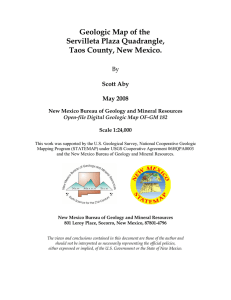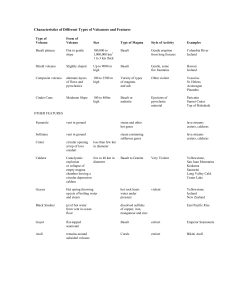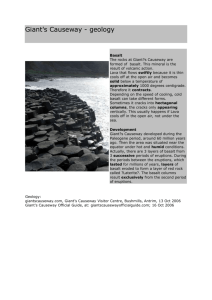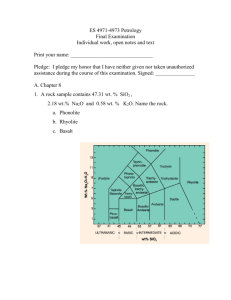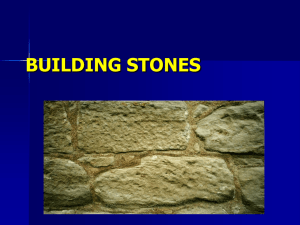Document 10950744
advertisement
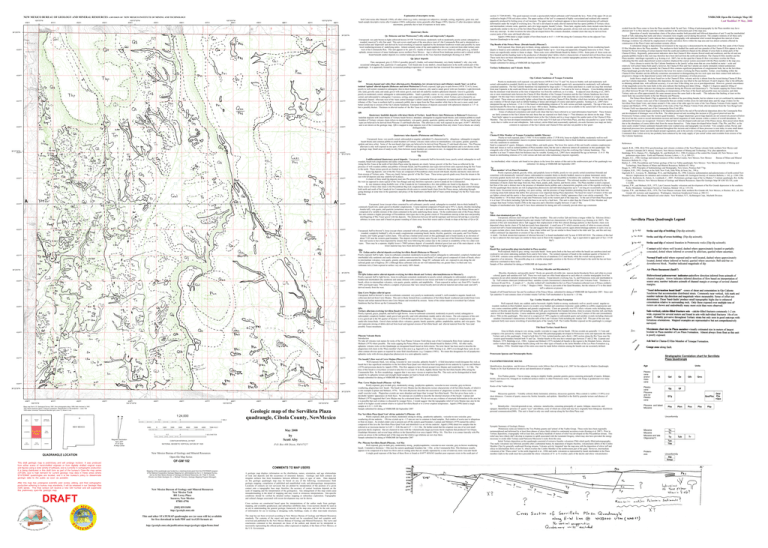
Explanation of descriptive terms.
NEW MEXICO BUREAU OF GEOLOGY AND MINERAL RESOURCES A DIVISION OF NEW MEXICO INSTITUTE OF MINING AND TECHNOLOGY
410000
106°0'0"W
411000
412000
105°57'30"W
413000
414000
415000
416000
105°55'0"W
417000
418000
419000
420000
421000
105°52'30"W
Soil Color terms after Munsell (1994); all other colors (e.g. rocks, outcrops) are subjective; strength, sorting, angularity, grain size, and
hand-sample descriptive terms after Compton (1985); sedimentary terms generally after Boggs (1995). Queries (?) after descriptors indicate
uncertainty, generally due to lack of exposure in loose units.
422000
Quaternary Rocks
36°30'0"N
36°30'0"N
4039000
4039000
Qe Holocene and late Pleistocene(?) silty eolian and slopewash(?) deposits
Unexposed; very pale brown-to-light yellowish brown (10 YR 7/4-6/6);loose; moderately well-to-moderately poorly sorted, subangular-torounded; massive(?); silty fine sand. This unit covers small parts of the area above (east of ) the Commanche Rim and is interpreted as a
mixed eolian and 'slopewash' unit derived by local reworking of material supplied by the dominant Southwest winds (and possibly by more
local weathering/erosion of underlying units). Almost certainly some of the sand supplied in this way is derived from older tertiary units
west of the Commanche Rim. This unit appears to be part of a mantle of 'desert loess' that covers relatively stable parts (e.g. isolated
uplands, stream terraces) of many landscapes across northern New Mexico. Age is inferred from landscape position and a cultural artifact
found beneath sandier deposits in a similar landscape position on the Taos Junction Quadrangle (Koning et al, 2007)
Qp 'playa' deposits
Thin; unexposed; grey (2.5YR 6/1-possibly gleyed?), friable, well sorted (bimodal), very thinly bedded(?) silty clay with
occasional subangular, fine, quartzose (?) sand grains. Unit found only in one shallow, closed depression in the north central part of the
quadrangle. It is apparently formed by occassional ponding/evaporation of rainwater that has winnowed fine material from nearby Tbs and
Qea.
4038000
Tbp Basalts of the Petaca Mesas (Dorado basalt) (Pliocene?)
Well exposed; blue, bluish grey-to-black; strong; aphanitic; vesicular-to-non vesicular; quartz-bearing; brown-weathering basalt.
Quartz is found as semi-euhedral crystals and in lens-shaped 'bodies' up to ~2cm long and apparently elongated transverse to flow. These
lenses are superficially similar to fiame in shape. These rocks were called Dorado Basalt by Barker (1958). Some parts of these rocks are
flow-banded and this banding leads to the production of abundant 'platy' debris which is characteristic of material derived from these mesas.
These rocks have not been radiometrically dated to our knowledge but they are in a similar topographic position to the Pliocene Servilleta
Basalts of the Taos Plateau.
Sample submitted for dating at NMBGMR lab September 2007
Tertiary Sedimentary and Volcanic Rocks
To
4038000
Ojo Caliente Sandstone of Tesuque Formation
Qal
4037000
4037000
Stream channel and valley-floor alluvium,active floodplains, low stream terraces and tributary mouth 'fans'; as well as
isolated 'upland' alluvial deposits (Holocene and latest Pleistocene?)-Poorly exposed; light gray-to-pale brown (10YR 7/2-6/3); loose;
poorly to well-sorted; rounded-to-subangular; thin-to-thick bedded or massive; silty sand to sandy gravel with rare boulders. Light-brownish
silty sand, gravelly sand, and sandy gravel with minor gravel, mud and silt underlies modern ephemeral channels. Gravel is generally
poorly-to-moderately sorted, subangular to subrounded pebbles. Sand is generally coarse- to very coarse-grained, poorly to moderately
sorted, and subrounded to subangular. Coarsness, sorting, and composition of Qal is controlled by which Tertiary unit is drained by an
individual channel. Alluvium west of the 'main central drainages' (called Canada de los Commanches in southern half of Quad and unnamed
tributary of Rio Tusas in northern half) is commonly pebbly due to input from the Plaza member while that to the east is more sandy (and
better sorted) due to erosion of the Ojo Caliente Sandstone. Estimated thickness of deposits associated with ephemeral channels is 1-5+ m
but is possibly thicker. Thickness in alluvial reaches of the Rio Tusas is unknown.
Qlb
4036000
4036000
Quaternary landslide deposits with intact blocks of Tertiary basalt flow(s) (late Pleistocene to Holocene?) Quaternary
landslide deposits with intact blocks of Tertiary basalt flow(s); abundant, subangular-to-angular basalt blocks; and common pebble-to-small
boulders of Tertiary volcanic clasts (silicic-to-intermediate), vein quartz, granite, quartzite, epidote and mica schist. All the non basalt clast
types are believed to be derived from Pliocene (?) sub-basalt alluvium. This alluvium is only well exposed in one spot ( 416977 :4036363)
and is not shown on the geologic map. Qlb is mapped in slope deposits west of the Commanche Rim only where Toreva blocks are clearly
distinguishable.
Qt
Quaternary talus deposits (Pleistocene and Holocene?).
36°27'30"N
4035000
4035000
36°27'30"N
4034000
4033000
section 31 T26N:R10E). This good exposure reveals a spectacularly baked carbonate soil(?) beneath the lava. Parts of the upper 20 cm are
oxidized to bright (5YR) red colors colors. The upper surface of the 'soil' is composed of highly vesciculated and oxidized silty material
apparently produced by boiling away of soil moisture. The upper meter of sediment appears to have dewatered producing soft sediment
deformation under the weight of overlying lava. The soil is developed in sandy alluvial material that has sparse pebbles of Tertiary silicic
and intermediate volcanic rocks, quartzite, and a few large angular basalt(?) clasts. These later, angular mafic clasts include some that are
superficially similar to the lava of the Servilleta Plaza Quad Vent (Poa) and another greenish, olivine-rich rock not familiar to the author
from any outcrops. In other locations the talus (Qt) developed below Pbs contains abundant, rounded clasts that may be derived from
coarser parts of this same sub-basalt alluvium.
Appelt (1998) dated a single sample of Servilleta basalt at 4.63 +/- 0.09 Ma along the Commance Rim on the adjacent Taos
Junction Quadrangle to the south.
4034000
A
A'
Unexposed; loose; very poorly sorted; subrounded-to-angular; unbedded (?); characterized by ubiquitous subangular-to-angular
basalt blocks and common pebble-to-small boulders of Tertiary volcanic clasts (silicic-to-intermediate), vein quartz, granite, quartzite,
epidote and mica schist. Some of the non-basalt clast types are believed to be derived from Pliocene (?) sub-basalt alluvium. This Pliocene
alluvium is only well exposed in one spot ( 416977 :4036363-see discussion under Servilleta Basalt description) and is not shown on the
geologic map. Small areas of sandy-to-silty fines between coarse boulders are common-to-rare. As mapped this unit includes some small
basalt 'blockfields'.
Qg
Undifferentiated Quaternary gravel deposits. Unexposed, commonly buff-to-brownish, loose, poorly sorted, subangular-to-well
rounded, basalt-rich conglomerate and sandy conglomerate.
Along the Rio Tusas at the north of Servilleta Plaza some Qg deposits are clearly 'terrace gravels' of the Rio Tusas as reflected by the
presence of well rounded cobbles and pebbles of Dorado basalt, and Precambrian clast types derived from units exposed along the Rio Tusas
to the north. These terrace gravels are limited in extent and are often buried by a veneer of relatively fine (sandy and/or silty) material.
Some Qg deposits east of the Rio Tusas are composed of Precambrian clasts mixed with basalt, rhyolite and dacite clasts derived
from erosion of Tertiary units. These are clearly 'terrace gravels' of the Rio Tusas. These terrace gravels grade away from the stream to the
east with Qf deposits and may underlie Qf in places.
A cluster of three small Qg deposits inset into Pbs along the Commanche Rim are composed of clasts typical of Tertiary deposits to
the west (as opposed to clasts typical of the Taos Range) and may therefore represent a 'proto-Canada de los Commanches'.
In rare instances along foothills west of the Canada de los Commanches a few slate pebbles are found in Qg deposits. The most
likely source of these slate clasts is the Precambrian Big rock conglomerate (Koning et al., 2007). Deposits along the main central drainage
both north and south of the Canada de los Commanches divide seem to contain basalt clasts from the Petaca mesas, indicating throughgoing drainage at some time in the quaternary and piracy of the headwaters (northern half of 'main central drainage') by the Rio Tusas since
that time.
Qf Quaternary alluvial fan deposits.
4033000
Unexposed, loose (except where cemented by soil carbonate), poorly sorted, subangular-to-rounded, thin-to-thick bedded(?),
commonly basalt-rich, sandy gravel-to-boulder conglomerate. Coarse material composed of basalt (up to 95%+), dacite, rhyolite (including
Amalia tuff), vein quartz, and quartzite (sometimes mica-rich). This unit is derived from erosion on the slopes of the Petaca Mesas and is
composed of a variable mixture of the clasts contained in the units underlying those mesas. On the southwestern side of the Petaca Mesas
this unit contains a higher percentage of Precambrian clast-types due to the greater extent of Precambrian outcrop in that area and possibly
interfingering of 'Rio Tusas' gravel with fan deposits. The distinction between Qf and Qt (upslope) and between Qf and Qg is somewhat
arbitrary in some cases and is based on greater rounding of clasts away from their source and/or a break in slope at the base of Qt or Qf.
QTg
4032000
4032000
4031000
4031000
36°25'0"N
36°25'0"N
4030000
4030000
Unexposed; buff-to-brown(?); loose (except where cemented with soil carbonate, presumably); moderateley-to-poorly sorted; subangular-torounded; complexly bedded(?); silty-to-sandy conglomerate containing basalt, dacite, rhyolite, quartzite, vein quartz, and Tres Piedras
Granite, and Vadito group(?) schist clasts. This unit has a limited aerial extent on this quadrangle and is found mainly at an elevation of
about 7120' near the western quad boundary. This deposit overlies Tertiary units (Tp and Tc) just east of the Proterozoic/Tertiary contact
here and seems to have been deposited by streams that were following this contact due to the contrast in erodability of the two older rock
types. There may be a separate, slightly lower (~7080') primary deposit of essentially identical gravel just east of the main deposit or this
lower material may have been derived by hillslope erosion of the higher gravel.
Qea
Tb Eolian and/or alluvial deposits overlying Servilleta Basalt (Holocene-to Pliocene?)
Poorly exposed; buff to light, loose-to-carbonate-cemented; moderately-to-poorly sorted; subangular-to subrounded; complexly bedded and
interbedded silty sandstone and sandy siltstone with common-to-rare lenses and beds(?) of sandy gravel composed of clasts of basalt, silicicto-intermediate volcanics, vein quartz, granite, epidote, and amphibolite. Stage III+ carbonate soils are exposed in cuts along the old
railroad grade east of highway 285. (Although these carbonate soils are not well indurated they are greater than 2 m thick and very
varbonate rich.) Clasts exposed at surface vary are nearly 100% basalt .
Qea
Tb+QPa Eolian and/or alluvial deposits overlying Servilleta Basalt and Tertiary alluvium(Holocene-to Pliocene?).
Poorly exposed; buff to light brown, loose-to-carbonate-cemented; moderately-to-poorly sorted; subangular-to subrounded; complexly
bedded and interbedded silty sandstone and sandy siltstone with common-to-rare lenses and beds(?) of sandy gravel composed of clasts of
basalt, silicic-to-intermediate volcanics, vein quartz, granite, epidote, and amphibolite. Clasts exposed at surface vary from 95%+ basalt to
100% non-basalt types. This reflects a complex of processes that have mixed locally-derived alluvial material and eolian sand (and silt?)
derived mostly from the west.
Qmc Cerro Mojino colluvial apron
Unexposed, buff-to brown(?), loose-to-carbonate cemented, very poorly-to moderateley sorted(?), well-rounded to angular, basalt-rich
colluvium derived from Cerro Mojino. This unit is likely formed from a combination of Servilleta Basalt weathered and eroded from Cerro
Mojino and eolian material blown onto Cerro Mojino and reworked by erosion. Some of the eolian material is reworked Ojo Caliente
Sandstone that has blown up the Commanche Rim.
4029000
4029000
4028000
QPa
Tertiary alluvium overlying Servilleta Basalt (Pleistocene and Pliocene?)
Poorly exposed; grayis, purplish, and buff to light brown; loose-to-carbonate-cemented; moderately-to-poorly sorted; subangular-to
subrounded; complexly bedded sandy gravel and gravelly sand with subordinate muddy and/or silty lenses. The sole exposure of this unit
is in a gravel pit in the NE quarter of Section 11 T25N:R10E (east of Cerro Mojino). This exposure is a mixture of conglomerate and
sandy/silty lenses/beds. Gravel clasts include silicic volcanics, granite, basalt, quartzite, gabbro, amphibolite, epidote, and vein quartz. This
unit represents mixing of debris derived from local and regional erosion of Servilleta basalt and alluvial material from the Taos (and
possibly Tusas) mountains.
4028000
Pliocene Volcanic Rocks
Introduction
We take all volcanic rock names for rocks of the Taos Plateau Volcanic Field (those east of the Commanche Rim) from Lipman and
Mehnert (1979) where possible. The rocks capping the Petaca Mesas were called Dorado basalt by Barker (1958). All other mafic,
aphanitic volcanic rocks on this Quadrangle are designated basalt based on field criteria. The term 'dacite' has been used to describe the
plagioclase-rich clasts in the 'Plaza member' (Tp) in this area (e.g. Ingersoll et al, 1990; Koning et al., 2007) even though these casts do not
often contain obvious quartz as required by some field classifications {e.g. Compton (1985)}. We retain this designation for all porphyriticaphanitic rocks with obvious plagioclase phenocrysts in a semi-aphanitic matrix.
4027000
4027000
4026000
4026000
36°22'30"N
36°22'30"N
410000
411000
106°0'0"W
412000
413000
414000
415000
105°57'30"W
416000
417000
418000
105°55'0"W
Base map from U.S. Geological Survey 1961, from photographs taken 1958, field checked in 1961.
1927 North American datum, Polyocnic projection. Reprojected to UTM projection -- zone 13N
1000-meter Universal Transverse Mercator grid, zone 13, shown in red
1:24,000
LAS
TABLAS
PETACA
PEAK
1
CERRO DE
LOS TAOSES
NEW MEXICO
LA MADERA
OJO
CALIENTE
SERVILLETA
Servilleta
PLAZA
Plaza
TAOS
JUNCTION
1000
TRES
OREJAS
CARSON
QUADRANGLE LOCATION
This draft geologic map is preliminary and will undergo revision. It was produced
from either scans of hand-drafted originals or from digitally drafted original maps
and figures using a wide variety of software, and is currently in cartographic production.
It is being distributed in this draft form as part of the bureau's Open-file map series
(OFGM), due to high demand for current geologic map data in these areas where
STATEMAP quadrangles are located, and it is the bureau's policy to disseminate
geologic data to the public as soon as possible.
After this map has undergone scientific peer review, editing, and final cartographic
production adhering to bureau map standards, it will be released in our Geologic Map
(GM) series. This final version will receive a new GM number and will supercede
this preliminary open-file geologic map.
DRAFT
0.5
0
1
Magnetic Declination
April, 2007
9º 33' East
At Map Center
0
1000
0.5
2000
3000
1 MILE
4000
5000
6000
0
7000 FEET
1 KILOMETER
CONTOUR INTERVAL 20 FEET
NATIONAL GEODETIC VERTICAL DATUM OF 1929
419000
420000
421000
105°52'30"W
422000
Geologic map of the Servilleta Plaza
quadrangle, Cibola County, NewMexico
May 2008
by
Scott Aby
P.O. Box 488 Dixon, NM 87527
New Mexico Bureau of Geology and Mineral Resources
Open-file Map Series
OF-GM 182
COMMENTS TO MAP USERS
Mapping of this quadrangle was funded by a matching-funds grant from the STATEMAP program
of the National Cooperative Geologic Mapping Act, administered by the U. S. Geological Survey,
and by the New Mexico Bureau of Geology and Mineral Resources, (Dr. Peter A. Scholle,
Director and State Geologist, Dr. J. Michael Timmons, Geologic Mapping Program Manager).
New Mexico Bureau of Geology and Mineral Resources
New Mexico Tech
801 Leroy Place
Socorro, New Mexico
87801-4796
[505] 835-5490
http://geoinfo.nmt.edu
This and other STATEMAP quadrangles are (or soon will be) available
for free download in both PDF and ArcGIS formats at:
http://geoinfo.nmt.edu/publications/maps/geologic/ofgm/home.html
A geologic map displays information on the distribution, nature, orientation, and age relationships
of rock and deposits and the occurrence of structural features. Geologic and fault contacts are
irregular surfaces that form boundaries between different types or ages of units. Data depicted
on this geologic quadrangle map may be based on any of the following: reconnaissance field
geologic mapping, compilation of published and unpublished work, and photogeologic interpretation.
Locations of contacts are not surveyed, but are plotted by interpretation of the position of a given
contact onto a topographic base map; therefore, the accuracy of contact locations depends on the
scale of mapping and the interpretation of the geologist(s). Any enlargement of this map could cause
misunderstanding in the detail of mapping and may result in erroneous interpretations. Site-specific
conditions should be verified by detailed surface mapping or subsurface exploration. Topographic
and cultural changes associated with recent development may not be shown.
Cross sections are constructed based upon the interpretations of the author made from geologic
mapping, and available geophysical, and subsurface (drillhole) data. Cross-sections should be used as
an aid to understanding the general geologic framework of the map area, and not be the sole source
of information for use in locating or designing wells, buildings, roads, or other man-made structures.
The map has not been reviewed according to New Mexico Bureau of Geology and Mineral Resources
standards. The contents of the report and map should not be considered final and complete until
reviewed and published by the New Mexico Bureau of Geology and Mineral Resources. The views and
conclusions contained in this document are those of the authors and should not be interpreted as
necessarily representing the official policies, either expressed or implied, of the State of New Mexico, or
the U.S. Government.
Tbx basalt(?) flow west of Cerro Mojino (Pliocene?)
Well exposed, black, very strong, vesicular-to- non-vesicular, aphanitic basalt(?). A field description would designate this rock as
basalt but it has superficial similarities to the Servilleta Plaza Quad vent which has been designated olivine andesite by Lipman and Mehnert
(1979) and pyroxene dacite by Appelt (1998). This flow appears to have flowed around Cerro Mojino and would then be < ~4.3 Ma. The
base of this basalt is everywhere covered in talus but it is at least 18 m thick, slightly thicker than the Servilleta basalts (Pbs) along the
Commanche Rim. Its flow morphology suggests that it was more viscous at eruption than Pbs. This rock can be distinguished in hand
sample by its aphanitic texture and strength (hand samples are hard to break with a hammer).
Sample submitted for dating at NMBGMR lab September 2007
Pbm Cerro Mojino basalt (Pliocene ~4.3 Ma)
Poorly exposed, grey-to-dark grey, moderateley strong, porphyritic-apahnitic, vesicular-to-non vesicular, grey-to-brown
weathering, plagioclase-rich basalt. The basalt of Cerro Mojino has the dikytaxitic texture characteristic of all Servilleta basalts, of which it
is one example (Lipman and Mehnert, 1979). The term dikytaxitic describes the association of plagioclase crystals in these rocks with
small vescicles/voids. Plagioclase crystals are more abundant and larger than 'average' Servilleta basalt. This fact gives these rocks a
decidedly 'sparkly' appearance on fresh faces. No outcrops are available to describe the internal structure of this basalt. Lipman and
Mehnert (1979) suggested that Cerro Mojino may be a structural dome. We do not see any evidence of structural deformation in the area but
it is possible that such evidence is obscured by younger flows. I would suggest that the topographic relief of Cerro Mojino may also be the
result of its higher crystal content relative to typical Servilleta Basalt or to a lower eruption temperature. Appelt (1998) dated a single
sample at 4.32 +/- 0.03 Ma.
Sample submitted for dating at NMBGMR lab September 2007
Poa 'Servilleta Plaza Quad Vent' olivine andesite(?) (Pliocene ~4.5)
Poorly exposed, dark grey-to-black, moderately strong-to strong, porphyritic-aphanitic, vesicular-to-non vesicular, greyweathering olivine andesite. Olivine crystals up to ~1.5 mm are rare to common in hand samples. Red cinders of scoria rare to ubiquitous
in float on slopes. An eroded cinder cone is present just off the eastern quad boundary. Lipman and Mehnert (1979) named the edifice
composed of this lava the 'Servilleta Plaza Quad Vent' and identified it as an 'olivine andesite'. Appelt (1998) dated two samples that he
referred to as 'pyroxene dacites' to 4.69 +/- 0.06 Ma and 4.27 +/- 0.11 Ma. He further noted that this eruption was one of several small
pyroxene dacite eruptions that are clustered in time with the volumetrically larger pyroxene dacite eruptions that produced Tres Orejas,
Guadalupe Mountain, and several large edifices in the Questa/Red river area (Appelt 1998 p. 38). This flow is in contact laterally with Pbs
across an arroyo in the northeast part of the map area but relative age relations are not clear there.
Sample submitted for dating at NMBGMR lab September 2007
Pbs Pliocene Servilleta Basalt (Pliocene, ~4.6 Ma)
Well exposed, grey-to-dark grey, moderateley strong, porphyroapahnitic, vesicular-to-non vesicular, grey-to-brown weathering
basalt. Cumulative thickness > 30m near the eastern quadrangle boundary but <10m at the Commanche Rim. This thickness usually
appears to be composed of at least two flows and or cooling units that are usually separated by a zone of relatively more vesicular basalt.
A single good exposure of the base of these flows is found at 416977 4036363 (another poor exposure exists in the south part of
Poorly-to-moderately-well exposed; very pale brown (10YR 8/2-3 to 7/3 and 7/4), loose-to friable; well and moderately well
sorted; subrounded-to-rounded; thickly-to-very thickly bedded and cross-bedded; quartz-rich, uncemented-to moderately well carbonatecemented sandstone. The Ojo Caliente Sandstone was deposited by large-scale (~1-7m) eolian sand dunes in a sand sea (erg) that stretched
from near Espanola in the south and Dixon in the east, and at least as far north as Taos and as far west as Abiquiu . Cross-bedding indicates
that the dominant wind direction at the time of deposition was from the southwest, as it is today. In adjacent areas (Koning et al., 2007)
one or more transitional units between the Chama-El Rito Member of the Tesuque Formation and the Ojo Caliente Sandstone have been
mapped. On this map I have restricted the Ojo Caliente to the 'classic' eolian part of the strata that are cross-bedded on a large scale and
well sorted. These strata are universally lighter colored than the underlying Chama-El Rito Member which here includes all strata that show
any evidence of fluvial origin such as tabular bedding or lenses and stringers of coarse sand and/or granules. Koning et al., (2007) have
interpreted the age as between ~13.4-11.0 Ma based on interbedding relations of To with various ash beds regionally. The top of this unit is
buried beneath Pbs flows but it appears to be at least ~400 m thick. Bedding attitudes are not available in the eastern half of the outcrop area
and this thickness estimate may be exaggerated if dips shallow to the east.
Zones of enhanced cementation and small scale shear that have been referred to as 'sand deformation band faults'. These features
are fairly common in the Ojo Caliente but only those that are exposed over fairly long (>~75m) distances are shown on the map. These
'band faults' appear to accommodate distributed strain in the Ojo Caliente and (to a lesser degree) the sandier parts of the Chama-El Rito
Member. They are best developed immediateley west of the main N-S fault east of Servilleta Plaza, and they run parallel to a 'grain' in these
rocks that is visible on air and orthophotos. Sub-vertical, calcite-filled (and ocassionally opalized), cm-scale fractures (see map) are fairly
common in exposures of the Ojo Caliente and Chama-El Rito and also run parallel to this 'grain'.
Tc
Chama-El Rito Member of Tesuque Formation (middle Miocene)
Poorly-to-well exposed; pink (7.5YR 7/3-4) to reddish yellow (7.5YR 6/6); loose-to-slightly friable; moderately-well-to-well
sorted; subangular-to-subrounded; massive-to-planar laminated (rarely cross-bedded), thin-to-thick bedded and sometimes lensoidal; quartzrich silty sandstone-to-sandstone.
Sand is composed of quartz, feldspars, volcanic lithics, and mafic grains. The lower few meters of this unit locally contains conglomerate
beds and lenses as well as isolated pebbles of Plaza member clasts, but the unit is otherwise almost all sandstone on this quadrangle. The
orangeish color of the Chama-El Rito has proved characteristic in distinguishing it from the overlying Ojo Caliente Sandstone. This
member is at least 75 meters thick but thickness may be variable. Koning et al., (2007) have interpreted the age as between 13.4-15 Ma
based on interbedding relations of Tc with various ash beds and other sedimentary deposits regionally.
An interbedded, white volcanic ash found in two places in the lower few meters of this unit in the southwestern part of the quadrangle was
submitted for dating at NMBGMR lab September 2007.
Tp
'Plaza member' of Los Pinos Formation
Poorly exposed; pinkish, greyish, white, and purplish; loose-to-friable; poorly-to-very poorly sorted (sometimes bimodal and
sometimes with dramatically 'outsized' clasts); subrounded-to-rounded; thinly-to-thickly bedded; massive-to-planar laminated; rarely
inversely-graded; dacite-rich silty-to-sandy pebble-to-boulder conglomerate and pebbly-to-bouldery silty sandstone. We here introduce the
informal designation 'plaza member' to replace earlier use of the term 'plaza lithosome'. This informal member is characterized by the
dominance of dacite clasts that range from red, blue, black, purple, pink, marron, and brown colors. The Plaza member is rarely exposed,
but float of this unit is distinct due to the presence of abundant dacite pebbles and a characteristic purplish color of the regolith overlying it.
On this quadrangle these dacites are rich in plagioclase phenocrysts and individual plagioclase up to 7 cm long are occasionally seen within
dacite clasts. Occasional inverse grading, very poor sorting, and the presence of large boulders protruding from the top of thin beds into
overlying strata both indicate that debris flow processes were important during Plaza deposition. The basal few tens(?) of meters of this unit
are lighter colored and the matrix is finer grained than avarage Tp so that it has a 'chalky' appearance (but is not calcite cemented). The
Plaza member is ~30 m thick where it laps onto Proterozoic rocks in the western part of the map area. To the east of Servilleta Plaza proper
it is at least 150 m thick (including Tpb) but the base is cut out by a fault here. This unit is older than the Chama-El Rito Member and
younger than basal Tertiary basalts (Tbb) in the map area and is therefore roughly between 15 and 27 Ma.
Samples of interbedded units Tpb and Tr have been submitted for dating and will eventually provide direct age constraints
.
NMBGMR Open-file Geologic Map 182
Last Modified 19 May, 2008
eroded from the Plaza center to form the Plaza member (both Tp and Tps). Filling of paleotopography by the Plaza member may have
allowed unit Tr to flow directly onto the Cordito member in the nortwestern part of the map area.
Deposition of mostly intermediate clasts of the plaza member both preceded and followed deposition of unit Tr and the interbedded
basalt of Tpb, indicating that mafic and silicic volcanism were roughly coeval during this period. The complex relations of all these early
Miocene (and late Oligocene?) units indicate that a complex topography with substantial relief existed throughout this interval of time.
Drainage evolution was effected by emplacement of mafic and silicic flows within the map area and was almost certainly effected by
construction of the Plaza Center and resultant isostatic effects.
A substantial change in depositional environment in the map area is demonstrated by the deposition of the fine sands of the ChamaEl Rito Member above the Plaza member. The medium-to thick bedded fine sands and rare granules of the Chama-El Rito appear to have
formed by fluvial reworking of eolian material from the south and southwest (based on the attitude of cross beds in eolian parts of the
Chama-El Rito). Regionally, paleocurrent indicators show that Chama-El Rito streams flowed south and southwest, and the silt and rare
granules/pebbles found in this rock may therefore have been derived from the north and northeast. The Chama-El Rito member and the
Plaza member interfinger regionally (e.g. Koning et al., 2007), but on this quad the Chama-El Rito everywhere overlies the Plaza,
indicating that this sandy depositional system somehow displaced the coarser system associated with the Plaza member in the map area.
I have chosen to restrict the Ojo Caliente Sandstone to the 'purely' eolian strata that are cross-bedded on meter + scale and
relatively well sorted ('dune-field sands'), however, the Chama-El Rito and Ojo Caliente are clearly intimately related sedimentary
sequences. In many locations regionally the Chama-El Rito contains significant proportions of conglomerate beds, but on the Servilleta
Plaza Quadrangle gravelly beds are restricted to the lower few meters overlying the Plaza member. Eolian cross-bedding within the
Chama-El Rito Member and the difficulty sometimes encountered in distinguishing the two rock types near their contact both indicate a
progressive change in the depositional system with time toward a dominance of eolian processes.
Aside from a single ash layer found low in the Chama-El Rito, volcanic activity is absent from the record during Chama-El Rito
and Ojo Caliente deposition. Sometime after deposition, the map area was tilted to the east between 10 and 6 degrees. Due to the difficulty
in obtaining attitude data with sufficient accuracy, it is not clear if this tilting was syn or post-depositional. However, general concordance
of dip magnitude across the main faults in this area indicate that faulting post-dates tilting. Slight (1-2 degrees) apparent tilting of
Servilleta Basalts further indicates that tilting has continued during the Pliocene and Quaternary(?). The basalts capping the Petaca Mesas
are offset between 90 and 120 meters (depending on interpretation of the base of the basalt and possible mass movements), and older
Tertiary units are offset approximately the same amount across this same fault to the south. This indicates that faulting, at least on this
maiin fault, has occurred mostly in the late Miocene and Pliocene.
The Petaca Mesa Basalt (Tbp) is apparently the oldest of the post-tilting basalts, but his relation is not yet confirmed by radiometric
dates. Ages of volcanic rocks east of the Commanche Rim are similar (within errors for individual dates and the range of dates for the
Servilleta Plaza Quad Vent), and cluster around 4.5 Ma, some of the older ages for rocks of the Taos Plateau Volcanic Field (Appelt, 1998;
Lipman and Mehnert, 1979). After deposition of the rocks of the Taos Plateau Volcnic Field, alluvial material from the Taos Range/Latir
Volcanic Field was deposited east of the Commanche Rim (Unit QPa).
Regional incision began sometime in the Quaternary and led to the end of fluvial/alluvial deposition above the Commanche Rim
and development of drainages west of the Rim. The oldest preserved unit recording this incision is QTg gravel preerved near the
Proterozoic/Tertiary contact near the western quad boundary. Younger Quaternary gravel (Qg) deposits are not extensively preserved below
this level but they seem to record intermittent incision and lateral migration of trunk streams within a context of overall denudation. No
substantial fill terraces are recognized. Extensive 'alluvial fans' were developed south and east of the Petaca mesas, their preservation likely
due to the abundance of coarse debris shed from the mesas themselves. Talus slopes developed below basalt ( Tbp, Pbx, and Pbs) as the
more easily eroded Tertiary sediments beneath tehm were washed away and topography was inverted. Very complex eolian, fluvial, and
slopewash processes have presumably operated throughout this incision and evidence of these processes is seen today in some small dunes
(especially 'coppice' dunes seen developed around vegetation), and in the actively evolving arroyo systems both above and below the
Commanch Rim. Eolian activity has probably been enhanced by the ready supply of 'pre-sorted' eolian sand available from erosion of the
Ojo Caliente Sandstone.
References
Appelt, R.M., 1998, 40Ar/39Ar geochronology and volcanic evolution of the Taos Plateau volcanic field, northern New Mexico and
southern Colorado [M.S. thesis]: Socorro, New Mexico Institute of Mining and Technology, 58 p. plus appendices.
Baldridge, W.S., Damon, P.E., Shafiqullah, M., and Bridwell, R.J., 1980, Evolution of the central Rio Grande rift, New Mexico: new
potassium-argon dates: Earth and Planetary Science Letters, v. 51, p. 309-321.
Bingler, E.C., 1968, Geology and mineral resources of Rio Arriba County, New Mexico, New Mexico
Bureau of Mines and Mineral
Resources Bulletin 91, 175p..
Barker, F., 1958, Precambrian and Tertiary geology of the Las Tablas quadrangle, New Mexico: New Mexico Institute of Mining and
Technology, State Bureau of Mines and Mineral Resources, Bulletin 45, 104 p.
Boggs, S., 1995, Principles of Sedimentology and Stratigraphy, New Jersey, Prentice-Hall 774p.
Compton, R.R., 1985, Geology in the field: New York, John Wiley & Sons, Inc., 398 p.
Ingersoll, R.V., Cavazza, W., Baldridge, W.S., and Shafiqullah, M., 1990, Cenozoic sedimentation and paleotectonics of north-central New
Mexico: Implications for initiation and evolution of the Rio Grande rift: Geological Society of America Bulletin, v. 102, p. 1280-1296.
Koning, D., Karlstrom, K., Salem, A., Lombardi, C., 2007, Preliminary geologic map of the La Madera 7.5-minute quadrangle, Rio Arriba
County, New Mexico, New Mexico Bureau of Geology and Mineral Resources, Open-file Geologic Map OF-GM XX-XX, scale
1:12,000.
Lipman, P.W., and Mehnert, H.H., 1975, Late Cenozoic basaltic volcanism and development of the Rio Grande depression in the southern
Rocky Mountains: Geological Society of America, Memoir 144, p. 119-154.
Lipman, P.W., and Mehnert, H.H., 1979, The Taos Plateau volcanic field, northern Rio Grande rift, New Mexico, in Riecker, R.E., ed., Rio
Grande rift: tectonics and magmatism: Washington, American Geophysical Union, p. 280-311.
Munsell Color, 1994 edition, Munsell soil color charts: New Windsor, N.Y., Kollmorgen Corp., Macbeth Division.
Tps
Silicic clast-dominated part of Tp
Unexposed, silicious clast-rich part of the Plaza member. This unit overlies Tpb and forms a tongue within Tp. Silicious (felsic)
clasts include grey-to-blueish banded rhyolite and Amalia Tuff which are characteristic of Tpc elsewhere (e.g. Koning et al, 2007). The
position of this unit immediately above Tpb suggests that emplacement of this flow altered drainage patterns so that rhyolitic clasts were
deposited where dacitic clasts of Tp had previously been deposited. A small area of Tr which consists mostly of white-to-cream colored,
crystal-rich tuff is found immediately above Tps and suggests that silicic volcanic activity again altered drainage patterns in such a way as
to again exclude silicic clasts from this area. Some clasts within unit Tps are similar to those found in the older unit Tpc, and this unit may
reflect continued Tpc deposition or erosion of Tpc at this time.
A small, ~5m thick stream-bed exposure of silicious breccia(?) is found interbedded with Tp near 413050 4031810. The relation of this bed
to Tps is unknown but clast types are similar to those seen in float in the mapped area of Tps. Age is equivalent to upper part of Tp (~15-20
Ma?)
Tpb
Basalt flow (and possible plug) interbedded in Plaza member
Well-exposed; black-to grey; strong; vescicular basalt. Some parts (both at the base and within the basalt) are autobrecciated and
oxidized to red colors indicating multiple flows and/or flow lobes. The isolated exposure of basalt in the southeast quarter of Section 16
T25N:R9E contains some autobrecciated basalt and rare breccia of sandstone (To?) and basalt, while the overall outcrop pattern is
suggestive of an intrusion. This possible plug is at a similar stratigraphic position to the flow(s) of Tpb found to the north but has not been
otherwise correlated to these rocks.
Sample of flow submitted for dating at NMBGMR lab September 2007
Tr Tertiary Rhyolite and Rhyodacite(?)
Rhyolite, rhyodacite, and possibly dacite? Rocks are generally divisible into maroon dacite/rhyodacite flows and white-to-cream
colored, quartz and sanidine-rich Tuff. These two rock types are often found adjacent to each other at a similar stratigraphic level but
exposures do not allow detailed interpretation of their relations. Found directly overlying Tpc, Tj, and Proterozoic rocks and interbedded in
Tp. Tuff contains chatoyant (irridescent blue) sanidine crystals ('moonstones') characteristic of the Latir Volcanic Field. Thickness is
between 40 and 50 m. A sample of “... rhyolite welded tuff {interbedded in the Los Pinos Formation}collected west of Petaca yielded a
potassium-argon age of 25.9 +/- 1.8 Ma..” Bingler (1968). Petaca is just north of the Quad Boundary, but the relation of Tr to this dated
tuff is unknown at present.
Sample of tuff found between Tps and Tp southeast of the Petaca Mesas submitted for dating at NMBGMR lab September 2007. Since unit
Tps underlies Tr and contains clasts of welded Amalia Tuff this Tuff interbedded in Tp must be <~25 Ma.
Tpc Cordito Member of Los Pinos Formation
Well exposed; black, tan, reddish, and/or brownish; slightly friable-to-strong; moderately well-to- poorly sorted; angular-torounded, medium-to-thick bedded; massive-to-weakly cross bedded and sometimes lenticular; sandy pebble-to-cobble conglomerate and
very coarse sometimes pebbly sandstone and granule conglomerate. Clasts are generally over 95% silicic volcanic rocks including many
varieties of rhyolite and rhyolitic tuff including Amalia Tuff, gray-to-blueish flow-banded rhyolite, white-to-creamy rhyolitic tuff, and black
and/or red flow banded rhyolite. Coarse sandstone and granule conglomerate comprises the lowest few(?) meters of this unit (immediately
above Tbb) on this quadrangle. This interval is composed of >99% angular-to-subrounded quartz and sanidine crystals including chatoyant
sanidine ('moonstone') characteristic of rhyolite tuffs of the Latir Volcanic Field including the Amalia Tuff. This part of the unit may
represent fairly near-source reworking of unwelded parts of the Amalia Tuff. The Cordito Member exposed on this quadrangle is younger
than Tbb.
Tbb Basal Tertiary basalt flow(s)
Gray-to-black, strong-to-very strong, usually vesicular-to-vuggy olivine basalt. Olivine crystals are generally <1.5 mm and
compose a few percent by volume of this rock. This basalt fills paleotopography developed in Proterozoic rocks and represents the oldest
Tertiary unit on this quadrangle. Found in both thin (5-15m), isolated patches and a thick (~200') section along the Rio Tusas near the
western quad boundary beneath both Tr and Tpc. Similar basalts in this area have retuned ages between 27 and 22 Ma. {Lipman and
Mehnert, 1979; Baldridge et al., 1980.) Lipman and Mehnert (1975) included all basalts in this region to the Hinsdale Series, whereas
earlier workers had mapped these basalts (along with two other types of basalt) as the Jarita Member of the Los Pinos Formation (e.g.
Barker, 1958). Detailed maps of the entire area must be made before relations among the basalts can me accurately defined.
Proterozoic Igneous and Metamorphic Rocks
Stratigraphic Correlation chart for Servilleta
Plaza Quadrangle
PALEOPROTEROZOIC ROCKS
Identification, description, and division of Proterozoic rocks follows that of Koning et al., 2007 for the adjacent La Madera Quadrangle.
Thanks to Dr. Karl Karlstrom for advice and identification of samples.
Xtp
Tres Piedras granite – Tan-to-orange, strong-to-slightly friable, granular granitic gneiss consisting principally of quartz, feldspar,
biotite, and muscovite. Orangish on weathered surfaces relative to other Proterozoic rocks. Contact with Xmqu is gradational over many
(tens?) meters.
Rocks of the Vadito Group
Xmqu
Micaceous quartzite – Variably colored, thinly laminated, schistose, micaceous quartzite. Mica content is varible (~5-50%) over
short distances. Consists of quartz, muscovite, biotite, hematite, and epidote. Identified in the field by granular texture and absence of
feldspar.
Xr
Metarhyolite – Greyish/greenish-to-tan, schistose metarhyolite, consisting principally of quartz, feldspar, muscovite, and
opaques. Identified by presence of quartz “eyes” and ribbons, some of which are zoned and may have originally been lithopysae (Karlstrom
personal communication2008). This unit is found in only one small outcrop along the Servilleta Plaza road.
Age
Pleistocene
and/or
Holocene
Units
Qt
Pleistocene
Pliocene
and /or
Pleistocene
Pliocene and latest
Miocene
Qal
Qe
Qg
Qf
Qlb
QTg
Pbs
Qea/Pbs
Pbm
Poa
Unconformity
Synoptic Summary of Geologic History
Proterozoic rocks are limited to the Tres Piedras granite and 'schists' of the Vadito Group. These rocks have been regionally
metamorphosed and deformed by at least three phases of stress likely related to continental accretion events (Koning et al. 2007). Prior to
Tertiary deposition, a topography with at least tens, and likely hundreds of meters of relief was developed on this Precambrian terrane. This
relief may have (likely did?) develop in response to uplift associated with the Laramide Orogeny, which may also have provided the energy
necessary to erode older Tertiary (and Paleozoic/Mezozoic?) rocks from this area.
Initial Tertiary deposition on this quadrangle consisted of extrusive basaltic volcanism (Tbb) which partly filled paleotopography.
This mafic volcanism was followed, possibly after a substantial hiatus, by deposition of largely rhyolitic, volcaniclastic debris of the Cordito
Member (Tpc) by generally southward flowing streams. Volcanic activity 'migrated' into the map area with the deposition of silicic tuff and
silicic-to-intermediate flows of unit Tr, which overlies the Cordito Member in the northwestern part of the quad. However, intermediate
volcanism of the “Plaza center” to the north (Ingersoll et al., 1990) and mafic volcanism as represented by basalt interbedded in the Plaza
member (Tpb) to the south must have preceded the silicic volcanism of Tr as Tr overlies parts of the dacitic and silicic volcaniclastics
Miocene
Miocene
Miocene and late
Oligocene(?)
Proterozoic
Qmc
To
Tc
Tp
Tpb
Tpc
Tbb
Unconformity
Xtp
Xmqu
Tr
Pbx
Pbp
Qea/
Pbs
+Qpa

